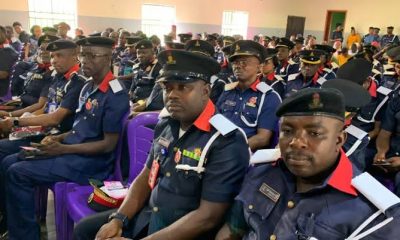News
FCT COMMANDANT, NSCDC, VISITS BRIGADE OF GUARDS, CALLS FOR PROGRESSIVE INTERAGENCY COLLABORATION.
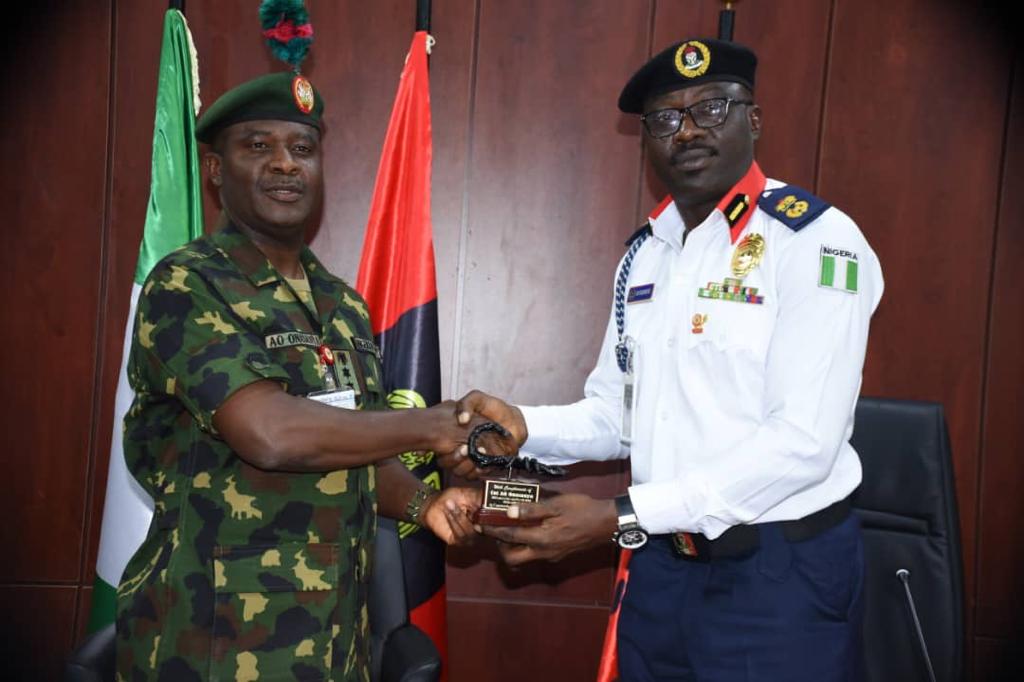
FCT COMMANDANT, NSCDC, VISITS BRIGADE OF GUARDS, CALLS FOR PROGRESSIVE INTERAGENCY COLLABORATION.
By: Michael Mike
The FCT Commandant of the Nigeria Security and Civil Defence Corps (NSCDC), Olusola Odumosu enliven esprit de corps today as he paid a courtesy visit to the Acting Guards Brigade Commander, Col. Olusola Adebisi Onasanya, ”the Chief Scorpion” at the Headquarters Guards Brigade, Abuja.
The Commandant, in appreciating the existing strong synergy between the Civil Defence and the Nigeria Army on one hand, noted that, while there is an increasing friendship and good bonding between senior officers in the military and other paramilitary agencies, same should be encouraged among the junior cadres in a progressive fashion till a full synergy is attained.
He condemned the rivalry occasionally experienced among security agencies and encouraged more collaboration for effective security coverage of the country.
“If we at our levels can enjoy so much cooperation and synergy, there’s a need to pass the same information to the lower rungs of the ladder too.

“My visit to you is more or less to fulfill customs and traditions. As far as I am concerned, we already have a good working relationship and I am enjoying maximum cooperation and synergy from you already.
“However, the visit is also an opportunity for me and my men to get acquainted with your men and familiarize with one another as we shall be meeting on the field in the course of our job”, he added.
Commandant Odumosu, while thanking the Commander, Guards Brigade for receiving him, his officers and men in audience, commended the Nigerian Army for its maturity and camaraderie which has resulted in a long standing good relationship with the NSCDC.
The Commandant noted that the Civil Defence Corps owed its evolution to the Military especially the Nigerian Army.
He pointed out that the Civil Defence came into existence during the Nigerian civil war of 70s, where there was a need to educate and also train the civilians on self defence and protective measures in the case of eventualities of the war.
He added that by the time the Corps became a full fledged paramilitary organization, core of the training of the NSCDC were basically from the Army.
“The two agencies have come a long way and should continue to collaborate more effectively and progressively for the safety of lives and property of Nigerians and other residents in the country.
“We are a product of the military, directly or indirectly”, Odumosu said.
The Commandant solicited more collaboration in the areas of operations and training for his men from the Brigade of Guards Commander. He reiterated that, with more training and retraining programs in place, all security agencies in the sub-sector will be able to operate and cooperate more efficiently without any one lagging behind in latest operational tactics.
Commandant Odumosu said that his mission to making the Federal Capital Territory (FCT) free of vandals of critical infrastructures such as manhole covers, street lights, traffic lights amongst other criminalities can not be done in isolation of other security agencies, hence, the necessity for the courtesy visit.
In his response, the Brigade of Guard Commander, Col. Olusegun Adebisi Onasanya, appreciated the courtesy visit and stated that the visit is a mark of continous synergy and interagency collaborations already existing among all the security agencies in the FCT.
He noted that there are already joint operations between the Civil Defence, other paramilitary agencies and the Nigerian Army which has been responsible for the downward trends of crimes and security threats in the FCT.
In response to the NSCDC’s request for training, the Brigade Commander promised to consult with the Defence Headquarters immediately and find out how the training of the NSCDC personnel will be undertaken.
“If I need to consult, I will consult, If I need to take permission or approval from the top, I will, but the training will be effected”, Onasanya promised.
He assured the FCT Commandant that, from time to time, enlightenment will be intensified among the junior cadres of the Nigerian Army to foster a healthier relationship with the NSCDC and other security agencies so as to enhance a unified front for security of the nation.
While wishing Commandant Odumosu and his team a very successful tenure at the FCT, he said that the visit is highly necessary for the officers of both agencies to meet for a better understanding of each other, stating that, the era of one agency doing it alone is over.
Also in attendance at the event with the Acting Guards Brigade Commander are Lt.Col SA Yahaya, Deputy Chief of Staff, Lt.Col Wom, Major JO Ogunbunmi, Major MN Yusuf, Major U.Adamu, Major T.Gboko, GY Rabiu and Captain SA Sitwan as well as the Guards PRO, Lt Olokodana.
After exchanging pleasantries, a souvenir of the Guards Brigade, a bourgeois looking crafted scorpion, the insignia of the Guards Brigade was presented to the visiting Commandant.
In the entourage of the FCT Commandant were his Head of Admin, HOD Critical National Assets and Infrastructure (CNAI), Head of Operations, HOD Intelligence and Investigation, Arms Commander among others.
FCT COMMANDANT, NSCDC, VISITS BRIGADE OF GUARDS, CALLS FOR PROGRESSIVE INTERAGENCY COLLABORATION.
News
APC commits to free, fair primary election in Adamawa
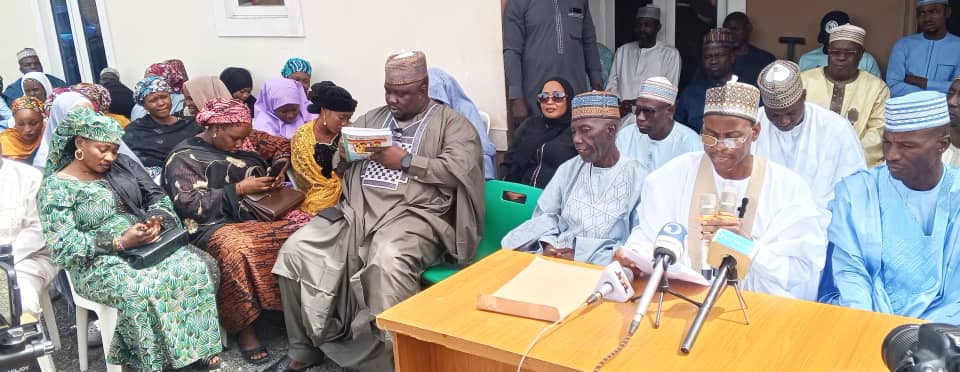
APC commits to free, fair primary election in Adamawa
The leadership of All Progressives Congress (APC) in Adamawa in partnership with the party’s Unity Forum is committed to conducting a free, fair and credible primary election in the state ahead of 2027 general elections.
Mr Abubakar Hamma-Girei, Director General of the Forum stated this at a press conference in Yola.
He said that the forum would ensure that all Party members have an equal opportunity to participate in the process, and that the outcome reflects the will of the party faithful.
He expressed gratitude to President Bola Tinubu and all stakeholders for the remarkable achievement recorded in the country that makes opposition to join the party
“We understand the importance of maintaining the trust and confidence of our members, and we are working tirelessly to ensure that the Primary Election is conducted in a transparent and accountable manner.
“Let me assure you that there will be no imposition of the candidate, and that will be free from any form of manipulation or interference.
“We will uphold the principles of internal Democracy and ensure that the best candidate emerges to fly our Party’s flag in the forthcoming elections”, he said.
The DG urged all party members to participate actively in the primary election and to report any irregularities or concern to the relevance authorities.
“Together we build a stronger more united Party that will deliver for our great nation.
“We are calling on all Nigerians who are passionate about positive change and good governance we invite you to join the All Progress Congress (APC) family”, he said.
According to him,, the ongoing membership revalidation exercise is a unique opportunity for shaping the future of the great nation.
Hamma further said that the forum also resolved to support all APC candidates in the forthcoming Local Government election in the state.
“We are directed to intimate all our members across 21 LGA to give them adequate support they deserve”, he said.
APC commits to free, fair primary election in Adamawa
News
Nigeria, Currently Dealing with Multiple Layers of Disease- Ministry of Health

Nigeria, Currently Dealing with Multiple Layers of Disease- Ministry of Health
By: Michael Mike
The Ministry of Health has raised the alarm over the changing health challenges in the country, warning that the country is currently dealing with multiple layers of disease at the same time.
Speaking at the official inauguration of the Nuparadigm Health Foundation, which marks a new era of health awareness and n the country, a representative of Ministry of Health, Abraham Emmanuel emphasized the urgent need for prevention, education, and lifestyle interventions to protect public health.

Nuparadigm Health Foundation is a non-governmental organisation committed to raising awareness about non-communicable diseases and the risk factors associated with them. The foundation aims to provide credible health information, educate communities, and encourage healthier lifestyles to prevent the onset of avoidable illnesses.
Emmanuel explained that Nigeria’s health challenges are changing, with the country now dealing with multiple layers of disease at the same time.
He said; “Africa, and Nigeria in particular, is no longer facing only communicable diseases. We are now experiencing a double burden of communicable and non-communicable diseases, and some even describe it as a triple burden when pandemics are included.”
He decried that younger Nigerians are increasingly affected, stating that: “Non-communicable diseases are increasing in Nigeria, and the age limit is dropping. Conditions like hypertension, stroke and type 2 diabetes are now affecting people in their 30s.”
Emmanuel noted that lifestyle is the main risk factor. He said: “These are mainly lifestyle-related diseases, which means they can be managed and prevented through increased awareness and better choices.”
He also highlighted alarming national survey findings, warning that many Nigerians are unaware of the silent health threats around them. “The data from our national survey is alarming. Many Nigerians are developing non-communicable diseases without knowing the risk factors, such as unhealthy diets, physical inactivity, harmful use of alcohol, tobacco use and even second-hand smoke,” he said.
Emmanuel, while lamenting that these risk factors which are often overlooked in daily life, are driving a surge in preventable illnesses, creating a hidden crisis that could overwhelm families and the healthcare system if urgent action is not taken.
On her part, the founder of Nuparadigm Health Foundation, Dr. Omolara Olagunju said her experience as a doctor led her to conclude that hospitals mainly treat disease, while true healthcare lies in daily prevention.
She said: “After about 15 years of medical practice, I realised that we don’t really have healthcare in the true sense. Hospitals are not health care systems; they are more like disease parlours. Real healthcare happens outside the hospital, and you should not have to be sick before you start thinking about how to be healthy.”
She explained that many Nigerians harm their health unknowingly because they lack access to simple, trustworthy information.
Olagunju said: “A lot of people are doing things every day that are damaging to their health, and they don’t even know it. When I tell them, they say, ‘Doctor, I didn’t even know.’ That is why we believe that everyone has a right to essential health information — the kind of information you need to maintain the good health that you already have.”
She also acknowledged the harsh realities of daily life, saying many people sacrifice health in the struggle to survive.
“People tell me they are too busy to come for health checks, and I later realised that their reasons are legitimate. People are trying to make ends meet in Nigeria. But sometimes we are working harder, winning the battle financially, and losing the war because our health is steadily deteriorating in the process.” She noted .
She emphasized that the foundation is designed to take health awareness directly into everyday spaces instead of waiting for hospital visits.
“Instead of waiting for people to come to the hospital, we decided to go to them to their offices, their schools and their social media platforms and share this information as widely as possible, because it may be just one piece of information that makes all the difference.” She said.
She also warned that unhealthy lifestyles learned early are already showing consequences in children.
“We were not born liking sugary drinks; these tastes were learned. Today, I see obese children everywhere, and I ask myself what will happen to these children in 10, 15 or 20 years if we don’t do something drastic now.” She warned .
In his keynote address, Consultant Physician and Interventional Cardiologist, Dr. Iseko Iseko said Nigeria invests more in treating illness than in preventing it.
“Over the last two decades in healthcare, most of what we do is secondary prevention treating diseases after they have happened and trying to prevent complications. But primary prevention, which is stopping diseases from happening through education and healthy practices, is where we should be investing more of our energy.” He said
Iseko warned that Nigeria’s fragile healthcare system is under strain from both infectious and lifestyle-related diseases
In his words he said “In Nigeria and sub-Saharan Africa, we are still dealing with communicable diseases like malaria, tuberculosis and HIV, but at the same time we are now seeing increasing cases of heart attacks, strokes and diabetes. This double burden of disease is putting enormous pressure on our healthcare system.”
He described Nigeria’s low life expectancy as a reflection of widespread preventable illness and weak preventive care.
He said: “A lot of Nigerians are dying prematurely, and Nigeria is now among the countries with the lowest life expectancy in the world. This is not because we lack potential, but because we have failed to prioritize preventive health and protect our population from avoidable diseases”.
Iseko stressed that everyday habits are driving diseases that drain families financially and emotionally, noting that:
“Many of the diseases we see today are lifestyle-driven and preventable. Treating heart failure alone can cost over ₦1.85 million every month, and when you look at conditions like stroke and kidney failure, the cost to families is catastrophic. This is why prevention, early detection and lifestyle change are far better than waiting to treat advanced disease.”
He further warned about lifestyle-related risk factors, stating that: “Sitting too much, smoking, unhealthy diets and alcohol are silently destroying our blood vessels. These are preventable causes of heart disease and stroke.”
Iseko emphasized the financial and health benefits of prevention, stressing that: “The average cost of treating heart failure is not less than ₦1.85 million per month. Treatment is expensive, catastrophic, and it is far better to prevent these diseases than to manage them.”
The event brought together healthcare professionals, government officials, and key stakeholders, emphasizing the urgent need for prevention, education, and lifestyle interventions to protect public health.
Nigeria, Currently Dealing with Multiple Layers of Disease- Ministry of Health
News
80-year-old ex-convict arrested as NDLEA uncovers illicit drugs in full body mannequins

80-year-old ex-convict arrested as NDLEA uncovers illicit drugs in full body mannequins
By: Michael Mike
An unrepentant 80-year-old grandpa Jeremiah Nkanta has again been nabbed for another drug crime by operatives of the National Drug Law Enforcement Agency (NDLEA) barely
three years after he was arrested, prosecuted and sentenced to two years imprisonment for dealing in illicit drugs,
A statement by the spokesman of the anti-narcotics agency, Femi Babafemi on Sunday said Nkanta, notorious for illicit drug business was first arrested by NDLEA on 14th December 2022, prosecuted and sentenced to two years in jail by a Federal High Court in Uyo, Akwa Ibom state.
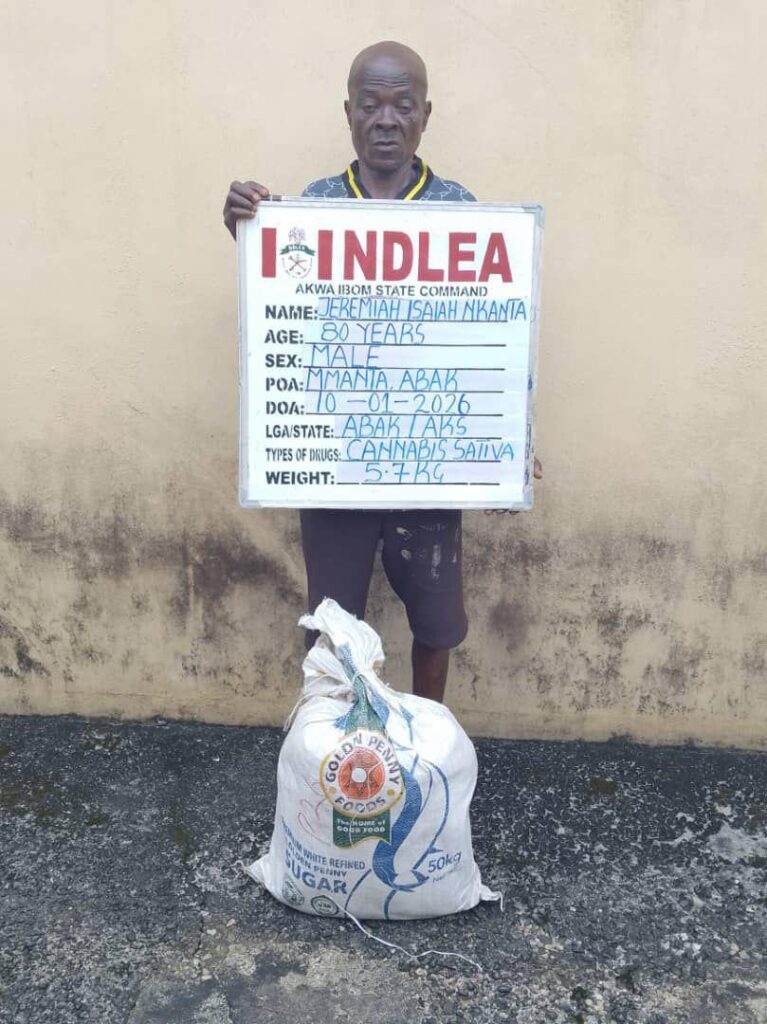
Babafemi said Nkanta not ready to let go the old habit, returned to the illicit drug trade and following credible intelligence, NDLEA operatives on Saturday tracked the Octogenarian ex-convict to his Mmanta – Abak village, Abak local government area of Akwa Ibom state, where he was arrested with 5.7 kilogrammes of skunk, a strain of cannabis in his residence.
The spokesman said in another successful interdiction operation in Akwa Ibom state, NDLEA operatives on patrol along Oron-Ibaka road in Oron local government area last Friday intercepted a 37-year-old businessman Ani Onyebuchi while travelling with full body mannequins for his clothing business in Cameroun, adding that a search of the mannequins revealed that they were stuffed with pills of tramadol weighing 5.3 kilogrammes.
He said the suspect claimed he resides in Cameroon and was reportedly returning to his base after the Christmas and New Year holidays when he was apprehended. It was revealed that he bought the drugs in Onitsha, Anambra state and was trafficking them to Cameroon to sell, using two mannequins to conceal the opioids.
In Oyo state, raids across different locations led to the seizure of dangerous illicit drugs and arrest of notorious dealers, including 45-year-old Remi Bamidele (Alias ‘Aluko the Mafia’) at Sasa, Ibadan, where a total of 10.696 kilogrammes of Colorado, Scottish Loud, Ghana Loud, Canadian Loud and skunk, all strains of cannabis.
Babafemi said at the time of his arrest last Thursday, two vehicles: Toyota Venza and Toyota Yaris marked HG 06 LYD were recovered from him.
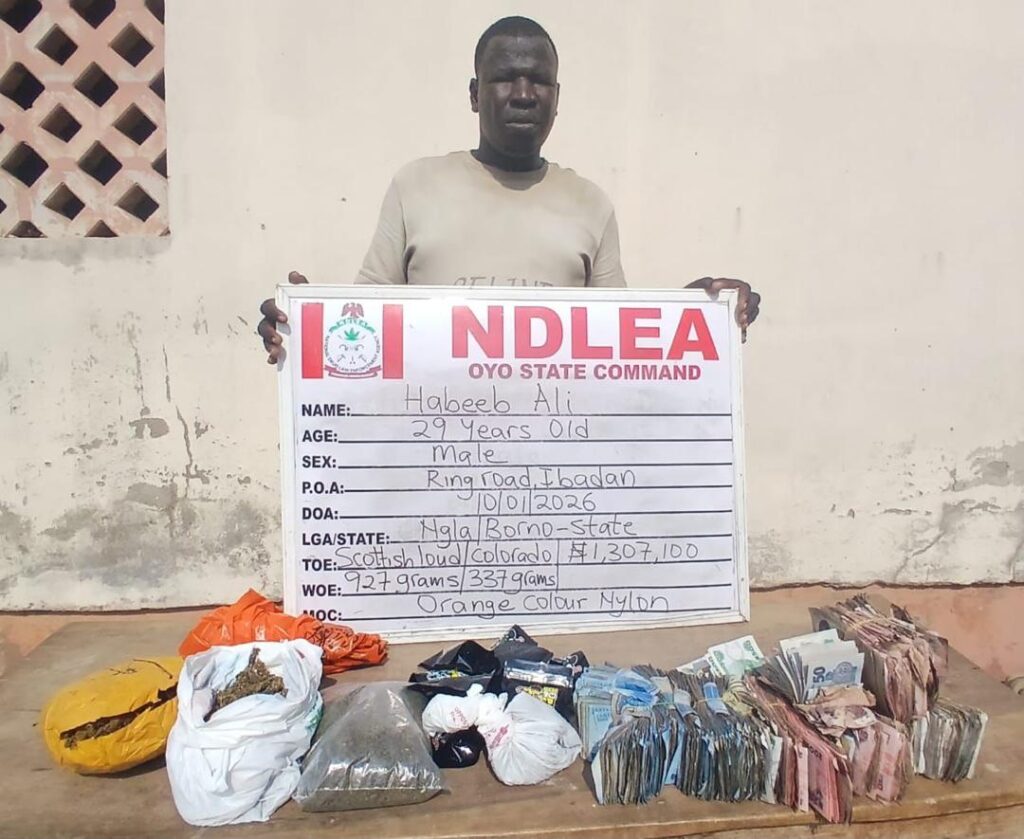
At Adegbayi area of the state capital Ibadan, NDLEA officers lastbFriday arrested Adeola Toheeb, 27, with various quantities of Colorado, Ghana Loud and skunk while Habeeb Ali, 29, was nabbed at Ring road, Ibadan with 1.264 kilogrammes Colorado, Scottish Loud and skunk. Not less than
₦1,307,100 cash exhibit was also recovered from him at the point of his arrest on Saturday.
A dispatch rider Osagbovo Edigin, 30, and two other suspects: Ebimi Labo, 28, and Akhimie Success, 25, were last Friday arrested at Ihama/Airport road GRA Benin City, Edo state in connection with the seizure of 118 grammes of Canadian Loud and a wrap of Colorado.
While Jimoh Agbonmhegbe, 49, was arrested at Irrua with 17.552 kilogrammes Colorado, Loud and skunk, another suspect Evelyn Okoyomon, 38, was nabbed at Ubiaja with 930 grammes of skunk last Wednesday.
Babafemi said in Niger state, no fewer than 4,000 pills of tramadol 225mg were recovered from a suspect Nazifi Umar, 22, at Dakwa town, Tafa local government area, while another suspect Yusuf Usman, 41, was nabbed with 100 blocks of skunk weighing 47 kilogrammes at Lankaviri, Yorro local government area, Taraba state last Wednesday.
Not less than 30,950 capsules of tramadol, he said were recovered from the home of a suspect Ugwoke Chibueze, 40, in Bachure area of Yola South local government area, Adamawa state following his arrest at the Lamido Aliyu Mustapha International Airport Yola last Tuesday.
Babafemi said with the same vigour, commands and formations of the agency across the country continued their War Against Drug Abuse (WADA) sensitization activities to schools, worship centres, work places and communities among others in the past week.
Meanwhile, the Chairman/Chief Executive Officer of NDLEA, Brig. Gen. Buba Marwa (Rtd), while commending the officers and men of Akwa Ibom, Adamawa, Taraba, Edo, Oyo, and Niger commands of the agency for the arrests and seizures, stated that their operational successes and those of their compatriots across the country especially their balanced approach to drug supply reduction and drug demand reduction efforts are well appreciated.
80-year-old ex-convict arrested as NDLEA uncovers illicit drugs in full body mannequins
-

 News2 years ago
News2 years agoRoger Federer’s Shock as DNA Results Reveal Myla and Charlene Are Not His Biological Children
-

 Opinions4 years ago
Opinions4 years agoTHE PLIGHT OF FARIDA
-

 News9 months ago
News9 months agoFAILED COUP IN BURKINA FASO: HOW TRAORÉ NARROWLY ESCAPED ASSASSINATION PLOT AMID FOREIGN INTERFERENCE CLAIMS
-

 Opinions4 years ago
Opinions4 years agoPOLICE CHARGE ROOMS, A MINTING PRESS
-

 News2 years ago
News2 years agoEYN: Rev. Billi, Distortion of History, and The Living Tamarind Tree
-

 ACADEMICS2 years ago
ACADEMICS2 years agoA History of Biu” (2015) and The Lingering Bura-Pabir Question (1)
-

 Columns2 years ago
Columns2 years agoArmy University Biu: There is certain interest, but certainly not from Borno.
-

 Opinions2 years ago
Opinions2 years agoTinubu,Shettima: The epidemic of economic, insecurity in Nigeria


